Welcome to the week. Here are the most notable news items our community has come across in the past seven days…
Who-ser pays?: This very relevant article as Oregon lawmakers (and the USDOT for that matter) ratchet up campaigns to reform transportation funding, lays out the myth that drivers (or any users) pay for the roads they use. (Union of Concerned Scientists)
No VMT, just let me be: A bill moving through the Arizona legislature would result in a ballot measure that would give voters the ability to prohibit government from tracking miles traveled as part of transportation funding or policy programs. (Arizona Free News)
Trump funding backgrounder: Education is one of the most powerful tools we have to counter the Trump dictatorship and their assault on transportation funding programs. Read this update from a major national advocacy group to learn more. (T4 America)
Ford’s follies: A court has denied an injunction request brought by cycling advocates in Toronto and now Doug Ford’s government can begin removing bike lanes this week. (CBC)
The Tesla tide: Anti-Elon Musk protests at Tesla dealerships have scratched a major itch among many Americans, but what if this is just the beginning of a larger, anti-automobile backlash? (Streetsblog USA)
Bad drivers and bipartisanship: Good news from Minnesota where lawmakers and Governor Tim Walz (remember him?) are coming together across the aisle on several bills that seek to reduce dangerous driving. (MPR News)
Bike parking politics: Advocates in New York are worried that a floundering and embattled mayoral administration is ignoring a promise to build out an extensive network of bike parking facilities. The article mentions the “bike hangar” I covered last week. (Streetsblog NYC)
How we treat aviation safety: The reader who shared this story said I should read it while replacing “aircraft” and “aviation” with “car” and “driving.” Imagine if we responded to car crashes like this! (NPR)
Racing while pregnant: A professional gravel racer shares her experience and thoughts about competing while carrying a baby and says she’s not being reckless while “racing for two”. (Cycling Weekly)
Thanks to everyone who sent in links this week. The Monday Roundup is a community effort, so please feel free to send us any great stories you come across.


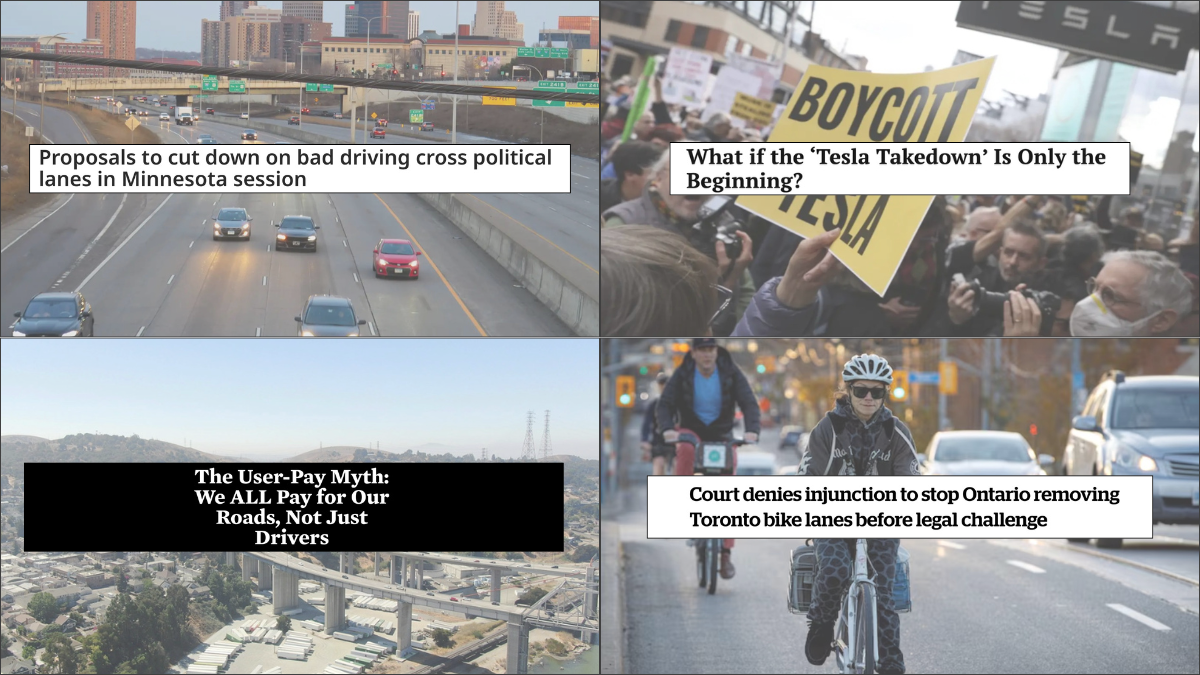
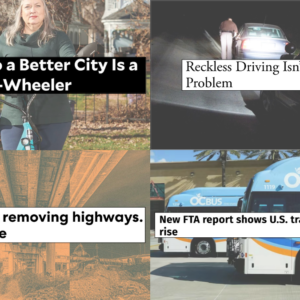
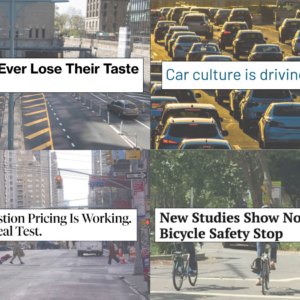
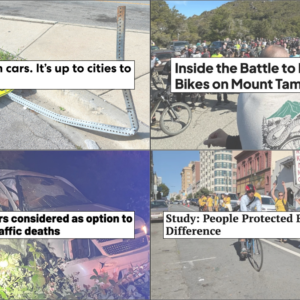
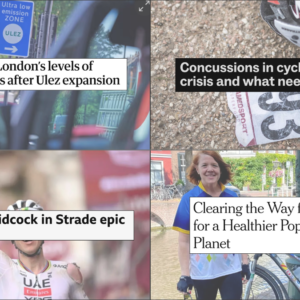
Thanks for reading.
BikePortland has served this community with independent community journalism since 2005. We rely on subscriptions from readers like you to survive. Your financial support is vital in keeping this valuable resource alive and well.
Please subscribe today to strengthen and expand our work.
The User Pay Myth piece is interesting. The graph of how roads are funded particularly so. But I don’t really see how it refutes the idea that user pay is not warranted for future funding outlays, as the current USDOT has stated. If anything, it reinforces the need for a user pays model as it relates to automobile infrastructure. Which seems fine by me. I think raising gas taxes and registration fees is a good idea for a lot of reasons, even if it is regressive.
What’s more interesting to me is the lack of political context around private public transit operators in the early 20th century. The reason that municipalities capped fares so strongly was that the general public tended to view them as corrupt monopolies – which they often were (at least until ~1920). This quote is also strange:
given that many of the subway lines in New York were famously constructed by private operators (and all of the lines constructed before 1932 were). The privately built IRT was basically immediately overcrowded upon opening. I’m fairly sure the first subway in the US (in Boston) was also built by a streetcar company. It wasn’t until after the automobile age when subway systems became unprofitable to build a strictly governmental affair (you can also see this dynamic in London).
I think it’s important to talk about this because part of why automobiles became so entrenched in American society probably stems from the perceived corruption and graft associated with transit franchises. Rather than reform an existing system to be more fair, most people preferred to use cars and highways as a means to compete with the only game in town. If you read about municipal politics in the 1920s to 1940s, this is a clear theme.
I feel like this same tendency – finding a new technology to get excited about, rather than messy reform of existing ones – is very present still in American culture. It’s why Portland felt the need to include “Fleets of electric, fully automated, multiple passenger vehicles” as a specific line item in the TSP, despite these vehicles not existing (well unless you count driverless metro systems like the Vancouver SkyTrain). I find it to be unfortunate and misguided – so many problems already have solutions, but we have a cultural context where it needs to be framed as a new breakthrough in order to get off the ground.
Thanks for the great information I didn’t know subway lines used to be constructed by private operators!
Maybe I’m in the minority but I didn’t know User-Pays was a myth other people believed.
Few thoughts – Isn’t use-pay basically impossible now with electric cars we can’t simply raise gas taxes. I think car registration probably doesn’t balance actual usage well and tracking miles is going to be too impractical. I like the idea though – especially if we biased it toward accounting for road wear / vehicle weight and perhaps emissions.
To some degree aren’t we all users anyway? even if I don’t own a car and only ride a bike I still get things delivered to my house via the roads, I can still call an ambulance and it will use the roads to get me.
And when I bicycle I also unfortunately have to use mostly roads…
Other ways of payment are possible – though of course the only place doing that (NYC) is having the Trump administration directly intervene in a user-pays policy for roads (though as it relates to capacity, rather than maintenance I suppose). And I doubt a VMT tax is in the cards based on this USDOT policy. Mostly because user-pay is almost surely unpopular no matter how its approached.
Yes – but ~100% of roadway projects are related to car/truck access, and a huge amount of that money is spent on peak-hour congestion relief. Allocating payment to a general fund then forces those who don’t use or need that congestion relief to fund it.
Essentially all legacy transit lines (pre 1930s) in the US were built by private operators – with an interesting exception for San Francisco, where the SF Municipal Railway (aka Muni) directly built all of the surviving light rail lines in the city (all but the most recent of which were built around 1915). More examples: the Loop in Chicago was built by a consortium of private companies controlled by Charles Yerkes, who later owned and operated UERL in London (the privately owned precursor to the London Underground), the Broad Street and Market-Frankford lines in Philly were built by private companies, and all of the subways in Boston were originally built by private companies as well.
The “we all pay” is the model used by a huge number of government services, many offering much less universal benefit than roads do; I understand the attraction of “user pays” but it really makes no sense to me except as a political tool to justify raising the gas tax or whatever (which I absolutely think we should do, significantly, regardless of what we’re spending on roads).
We clearly need to find a good revenue replacement for the gas tax, whether it be vehicle based or not. My personal choice, if a carbon tax is out, would be a federal mileage tax, which would greatly reduce the need to track where people are driving for assessment purposes, which I’d levy alongside a regularly increasing gas tax.
But I’m interested in hearing other ideas.
I don’t understand how a federal mileage tax could actually be implemented. Mandate GPS trackers? people could just take them out and leave them at home.
Odometer base? it’s very easy to disconnect odometers in many vehicles as well.
It would have to be odometer based. I am sure some would evade it, but how many?
Tax systems are rarely perfect.
Probably depends on the price and how easy it is. I think it’s trivial on nearly all motorcycles older than 10 year or so. I think some vehicles don’t even have odometers – for example motorcycles aren’t required to have them.
Also how does that work for private property use? say I take my vehicle to a track or ride it off road on private property, another state or country?
The reason I said a federal tax is it reduces the different county/state problem. An odometer tax would not work well for vehicles that are primarily used on private property… Unless you simply decouple mileage from its impact on roads, and just say we’re taxing this.
I don’t have any other ideas for generating revenue from vehicles, so if a mileage tax is not going to work, then maybe we have to give the idea of entirely and come up with a new way to raise money to pay for roads.
Or, if automation takes hold, maybe that would create some new opportunities for taxation.
There’s a lot of double-counting on that chart. Bonds and related Interest are paid for with the other revenue sources. Almost no government ever uses funds as they come in, they instead borrow from future revenue projections (and pay more interest when they inevitably screw up on the projections.)
Our early national government did in fact build a toll-free ‘national road’ way back when, now along the same course as I-40. Many of the pioneer trails were entirely toll-free, it really varied all over the country. Most roadways weren’t paved until the motorcar became popular, since you could get pretty much to any community of any size using our excellent commercial railroad network until about 1957. Our national non-interstate highway system dates from the 1920s and 30s and was implemented to compete with the railroads.
In fact I’m really stunned and amazed how little they talk about the commercial railroads in all of this, they simply don’t mention them outside of major cities. From 1840 through WW2 our country was built on railroads to move people and goods around, and shipping before then, yet they say nothing about it. A strange bias.
And Frank Zeidler and Dan Hoan are rolling in their graves (mayors of Milwaukee who very strongly advocated for minimal to no indebtedness for the municipal government on the grounds of interest payments benefiting banking interests). But I don’t think bonds being paid by other sources means double counting – a bond + repayment via the general fund is a different accounting/political process than a direct allocation from the general fund. At least in Oregon, bonds are typically guaranteed against property taxes and get preferential treatment over other revenue buckets.
A quick note on railway travel – it wasn’t until Amtrak day in April 1971 (or maybe the Penn Central bankruptcy) when railway travel became truly infeasible for most of the US. While most railway companies spent the majority of the 1960s rapidly abandoning passenger service on unprofitable lines, there was still plenty of service (especially relative to the situation when Amtrak took over). In 1965, the Pennsy had 10+ trains a day between Pittsburgh and Philly (page 178), Illinois Central had 4 trains a day between New Orleans and Chicago (page 440), the Milwaukee Road still had 8+ trains a day between Milwaukee and Chicago (page 548), and 4 to the Twin Cities. I think you get the idea – by the 60s, service was threadbare compared to the decades before, but it was still robust by our current standards, at least on the major company’s main lines.
Apparently, according to business directories from the time, Greensboro NC had over 100 passenger trains a day around 1908, which dropped to “only” 48 per day in 1950 (roughly a train every half-hour), all on commercial lines. By the 90s this was down to 4 per day, but now it’s 12 per day. In the 1950s the State of NC bought the main line between Charlotte and Raleigh and has since bought several other smaller lines, which they lease to the Norfolk & Southern big-6 railroad freight company (the other big-6 are BNSF, UP, CSX/Chessie, CN, & CP). The state runs NCDOT and Amtrak passenger trains on it and are gradually upgrading tracks and crossings for future high-speed trains, part of the DC to Atlanta SE Corridor. NC is a very conservative state, so this is NOT socialist. Not at all. Not even slightly.
If you travel between 2 NC cities by train, your bike travels for free on bike hooks.
From the MPR News article: “it’s just as dangerous going 70 miles per hour [in] a 30 mile per hour zone, as it is over 100 on a freeway,” she [chief of the Minnesota State Patrol] said.
Really??? Contrary to a freeway, a 30 mph zone has pedestrians, cyclists, vehicles turning out of intersections/driveways/parking lots, or even people sitting in their living rooms minding their own business… all situations in which a collision with a vehicle traveling at 70 mph is deadly almost every time. If you gave me the choice, I’d rather be struck from behind by a vehicle going the same direction as me at 100, than one t-boning me at 70, especially if I’m not in a metal cage with a crumple zone and air bags surrounding my body to absorb the kinetic energy.
To be clear, I’m not saying it’s great that people go over 100 on the freeway. That’s deadly and should be stopped. But speed differentials should be treated differently depending on the complexity of the streetscape. The way this bill is set up, a driver speeding through a school zone during school hours would only have their license revoked if they were doing 55 mph (aka, freeway speed) or higher. That’s bananas.
Correction: it’s a proposal, not a bill.